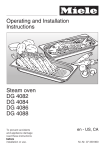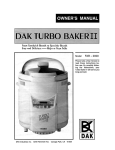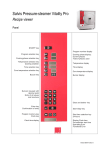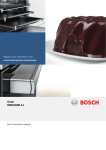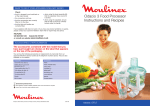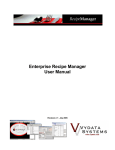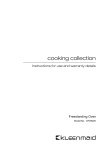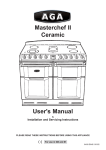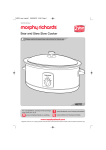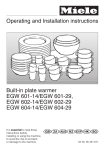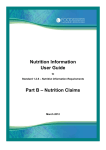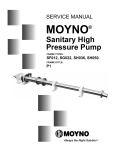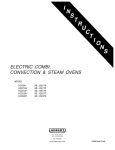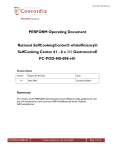Download CSD1012E! - AS Catering Supplies
Transcript
9 Convection Steam Ovens CS & CSD Series A INSTALLATION OPERATION A-VERSION 16/07/99 Instructions for Installation and Operation of CS and CSD Series Hobart Convection Steam Ovens Contents 1 Page INSTALLATION 1.1 Installation ............................................................................................. 3 1.2 Water Connection ................................................................................. 4 1.3 Electrical Connection ............................................................................ 5 2 OPERATION 2.1 Getting acquainted with your HOBART Combi Oven ............................ 6 2.2 Control Panel Symbols.......................................................................... 8 2.3 Operation of the control panel ............................................................... 9 2.4 Programming & Storing Cooking Programmes ................................... 12 2.5 Convection Mode ................................................................................ 17 2.6 Combination Mode – Steam and Convection ...................................... 20 Convection Mode with variable quantities of added steam ................. 23 2.7 Steam Mode ........................................................................................ 24 2.8 Low-Temperature Cooking .................................................................. 27 2.9 Core Temperature Cooking ................................................................. 28 2.10 DELTA-T Cooking ................................................................................ 30 2.11 Faults ................................................................................................. 31 3 CLEANING / MAINTENANCE 3.1 Care and Cleaning .............................................................................. 32 3.2 Maintenance ....................................................................................... 33 Machine noise level is ≤ 70 dB (A) Important Instructions for Use ● Use in Accordance with Regulations Hobart Convection Steam Ovens are only intended for baking, roasting, gratinating, steaming and stewing food products intended for consumption. ● Safety Do not wash down with a hose or a high pressure cleaner from outside. The "danger" symbol is shown beside instructions that are essential for the safe operation of the machine. Please read these passages with particular care. ● Liability Incorrect installation and repairs not carried out by Hobart Engineers or their Authorised Service Agent and any technical modification to the machine not authorised by the manufacturers may cancel the manufacturers guarantee. All examples given in these instructions with reference to cooking methods, times and temperatures are dependant on the quality of the foodstuffs being cooked and may therefore vary. 2 1 INSTALLATION 1.1 Installation 1.1.1 Transportation to Installation Site ● This should, if possible, be done while the appliance is still packaged and on the pallet, using rollers or a mechanical handling device. 1.1.2 Remove Packaging ● Snip off steel bands. ● Lift off outer carton. ≥ 20 1.1.3 Alignment on Installation Site ● If installing a CS/CSD 0612 / 1012 / 1022 on a stand it is necessary to remove the legs. The legs are only required if you are installing the unit on an existing bench. ● Check to ensure machine specification complies with order requirements and that it is the correct voltage. ≥ 150 ● Do not install with the sides close to hot equipment. ● The lateral distance between appliance and wall or other ≥ 50 ≥ 430 objects must be at least 50 / 430 mm and 150 mm on side with control panel (see fig.). ● Between the rear of appliance and wall must be a distance of 20 mm at least. ● Align using a spirit level. ● A gap of at least 300 mm must also be left above the appliance in order to ensure optimal functioning of the ventilation system. ● For floor models CS/CSD 2012 / 2022 it may be necessary to install the fixing plates provided to fix the oven to the floor. Using the roll in / roll out trolley (optional on CS/CSD 0612/2012) ● Ensure that the oven insert and/or tray trolley can easily be slid into the cooking compartment. ● If the appliance has to cross a grating, flat metal strips should be fitted to the floor for the wheels to run on. ● The site on which the oven sits and the surrounding floor area should be perfectly level to facilitate the roll-in roll-out trolley and the ability to level the oven during installation. ● Re-adjust the oven after it has heated up. 3 1.2 Water Connection ● Make the cold water connection to a supply of potable softened water. ● Maximum permissible static pressure: 6 bar - Minimum 0.5 bar. ● Provide a suitable pressure hose 1/2", B.S.P. union nut 3/4", stopcock,line strainer and a WRAS approved double check valve. ● If water hardness is greater than 6 Deg Clark, a water softener must be provided by the customer. ● Maximum water requirement: CS/CSD 1012 E = 30 l/h CS/CSD 1022 E = 50 l/h CS/CSD 0612 E = 18 l/h CS/CSD 2012 E = 50 l/h CS/CSD 2022 E = 80 l/h During breaks in operation (eg. overnight), close the stopcock. ● If the equipment is switched on with the water line turned off, an audible signal is sounded after approximately 5 minutes and the water failure symbol illuminates. WRAS approved double check valve p/n 143450 1.2.1 Condensate / Discharge ● Connection: B.S.P. 11/2" external thread for 0612, 1012, 1022, 2012 & 2022. The oven must be installed with the trap provided. ● Provide a tundish at site. min. 100 mm Do not locate the tundish underneath the machine. ● Drain must fall towards discharge end and must be supported to prevent sagging. ● Drain material must be suitable for water at a temperature of 100°C. Terminate the drain above the tundish. 1.2.2 Exhaust Air ● Exhaust air must be able to gain free access to a canopy. ● Do not cover up the exhaust air opening. Danger of injury: The exhaust air temperature can be as high as that in the cooking compartment. 4 1.3 Electrical Connection This should only be made by Hobart Engineers or other authorised Service Agents and must be in accordance with the installation requirements and all relevant regulations. ● Place the main isolator close to the machine (provided by customer). During prolonged breaks in operation, eg. overnight, the main switch must be put in the off position. 1.3.1 Checking ● Compare the data given on the data plate with that for the building’s power supply and the circuit diagram. ● Check that fuse protection and cables are adequate for the current load. 1.3.2 Connection (see floor plan) ● Draw cable (suitable for current capacity of the oven) through the entry bush joint on the underside. ● Connect cable to the terminal block. ● Tighten all screws in the control box (they may have loosened off during transportation). ● Tighten the entry bush compression nuts. ● The appliance must be earthed. The terminal screw is located directly beside the terminal block. ● This appliance is provided with a terminal for the connection of an external equipotential conductor. This terminal is located under the bottom of the oven close to the electrical grommet. 5 2 OPERATION 2.1 Getting Acquainted with your Hobart Convection Steam Oven 2.1.1 Door opening / closure ● The door of the appliance is fitted with an electrically powered lock. ● The appliance is delivered with the door unlocked and can be opened by firmly pulling the door handle. ● Push the door until it connects with the latch. This is the safety position which should be used when the oven is not in use, and also when the door is opened after cooking to allow excess steam to safely escape before fully opening the oven door. ● Push the handle until it is in line with the oven door. If the power has been connected, the door will now lock automatically, hermetically sealing the oven cavity. ● To release the door, pull the handle towards you, until it clicks into the open position. The oven door will then automatically be released to the safety position. Allow a few seconds for the excess steam to escape before pulling the door fully open. 2.1.2 Initial Operation Only to be done by a Hobart Service Technician or an Authorised Hobart Service Agent. Before the appliance is used it must first be preheated for at least one hour at a temperature of 250 Deg C. (see Chapter 2.5, convection mode). The aroma and smoke that are then developed are normal as the oven is burning off oils and grease used in production. ● Allow appliance to cool down and then clean it thoroughly. ● Check the door and re-adjust if necessary. Cooking programme can only be started with door closed. 6 2.1.3 Loading the oven ● Maximum load: CS/CSD-0612 = 30 kg CS/CSD-1012 = 50 kg CS/CSD-1022 = 100 kg CS/CSD-2012 = 100 kg CS/CSD-2022 = 200 kg ● Place the cooking load in appropriate container or on grid in accordance with the instructions for use and slide them into the insert. ● Loading of 10 level ovens: The insert may be left in the oven or can be used in conjunction the optional roll in / roll out trolley. ● Loading of 20 level ovens: With the door in fully open position – insert the tray trolley until the levers connect with the oven cavity facia. Lift the trolley handle until it stops. This will lower the tray insert into the oven chamber. Now withdraw the trolley. The insert is now held in place by two brackets fitted to the baffle at the rear of the oven. ● NB Anytime the roll in / roll out facility in the 10 level oven is not in use, you must ensure the insert retainer (delivered with the oven) is fitted under the fan baffle in order to prevent the insert from tilting when pans ere being removed (see fig.). 2.1.4 Unloading the oven DANGER – beware of excess steam and heat escaping from the oven chamber when the door is opened. ● Always allow the door to remain in the safety position for a few seconds to allow excess hot air/steam to escape. Always stand behind the door when fully opening it after the excess steam has escaped from the oven chamber. ● Always wear protective clothing when attending the oven during a cooking operation. ● Unloading of 10 level ovens: Product can be removed either directly from the oven leaving the insert in place or can be used in conjunction the optional roll in / roll out trolley. ● Unloading of 20 level ovens: With the door in the fully open position – insert the tray trolley until the levers connect with the oven cavity facia and the two hooks have connected with the tray insert. Lower the trolley handle until it stops. This will lift the tray insert from its retainer, securing it to the trolley. The trolley may now be removed from the oven with the tray insert securely held in place. 7 2.2 Control Panel Symbols Appliance ON Convection Vent open / closed Appliance OFF Combination steaming (Convection plus steam) Steam Start / Stop Phase pre-select pad Time or Core Temerature display Down Timer selection Core Temperature selection Up Temperature or DELTA-T display Down Set Temperature DELTA-T selection Up Program number selector Cooking program display Down Enter key Up HCPC function Half fan speed Humidifier / cool down Diagnostic fault 8 2.3 Control Panel Operation 2.3.1 ON / OFF On Key When the green LED and the cooking compartment both light up, the appliance is ready for operation. ATTENTION: open the water cock. To cancel a manual cooking programme of up to five phases press the On key once. Off Key This is pressed at the end of the day. After approximately 10 seconds the cooking compartment light goes out, vent opens and the steam generator automatically empties. 2.3.2 Cooking Modes Convection Key / Vent Position The green LED illuminates and the temperature display indicates 150°C. This temperature can be raised or lowered. For low temperature cooking, the hot air temperature is adjustable between 30°C and 99°C. This key also allows to set the vent position: upper LED illuminated – vent closed, lower LED illuminated – vent open. Steam Key The green LED illuminates and the temperature display indicates 100°C This temperature can be lowered. For low temperature cooking, the oven temperature is adjustable between 30°C and 99°C. Combination Steaming Key The green LED and the first LED in the phase display light up, and the temperature display indicates 150°C. This temperature can be raised or lowered. The quantity of steam can be set from 1 to 6 by pressing the combination steaming key. The line of LED's indicates the current setting. Start/Stop Key When this key is pressed, the cooking programme is started (the LED lights up) or stopped. If the door is not locked, the temperature display flashes. Phase Pre-Select (CSD-Model only) This key has several functions: – It permits a check to be made on the previous programmed cooking phase and further programming of the next phase. – During a cooking programme, the various phases are displayed when this key is pressed. The number of LED's that are illuminated indicates the number of phases in a cooking programme. The flashing LED indicates in which phase the cooking programme is currently engaged. 9 2.3.3 Time Pre-Select Time Display This display has several functions: – Display of the pre-selected time. – Display of the remaining running time for the cooking programme. – Display of the preselected core temperature. – Display of the actual core temperature. When the display shows [- --], the appliance is working in manual operation (no automatic switch-off at the end of cooking process). Time Check Key When this key is pressed, the pre-selected time is superimposed for approximately 5 seconds. Pressing this key also cancels the probe function. Core Temperature Key (CSD and EK Models only) When this key is pressed, the pre-selected time is disabled and the desired core temperature can be input. The green LED lights up when core temperature mode is selected. The display will read 60°C. When the products reaches the core temperature, the display flashes and the buzzer will sound every 45 seconds for 15 seconds. Adjustment Keys The timer or the core temperature can be adjusted up or down using the two adjustment keys. NOTE: Time pre-select is not operational in core temperature operation. To switch back to manual operation, press the Stop key. Press and hold the down key until the display shows [- --]. 2.3.4 Temperature Pre-Select Temperature Display This display has several functions: – Display of the pre-selected temperature. – Display of the actual temperature. – Display of the pre-selected temperature for DELTA-T. Temperature Pre-Select When this key is pressed, the pre-selected temperature is displayed in place of the actual temperature for approx. 5 seconds. DELTA-T Cooking (CSD Model only) When this key is pressed, the cooking temperature follows the core temperature with a constant difference. When this key is pressed the display will show 60°C. This can be adjusted using the adjustment keys between 20°C to 120°C in combi mode or from 20°C to 90°C in steam mode. Adjustment Keys These are pressed to adjust the desired temperature upwards or downwards. Note: The temperature can be set only after the cooking mode has been pre-selected. 10 2.3.5 Programming (CSD Models only) Display of Programme Number The display is blinking when the programme in use has been altered. The alteration is effective for this programme run only, the programme in memory remains unaltered. When the programme function is not used the display shows [--] for manual mode. To clear a manual mode programme in order to input a new cooking press the ON key once. Programme Key This permits the memory to be switched on or off for programming or cooking operation purposes. Programme Number Adjustment Key Enter Key When this key is pressed, a cooking programme that has just been input, with up to 5 phases, can be saved under a specified programme number. Caution: If a second programme is input under the same number, the display flashes. The previously stored programme can now be checked. Then: – either the new programme is saved under a different number – or the old programme is replaced by the new one. In this case, it is sufficient to press the input key until the display goes out (approx. 3 seconds) and two brief signals have been sounded. 2.3.6 Other Functions Half Fan Speed Key (CSD and EK Models only) Press once for 1/2 speed – LED flashes. Press twice for full speed – LED on constantly. This key is programmable. Humidity While this key is pressed, the humidifier is activated. Water is injected intermittantly if the oven is above 150°C. This key is not programmable. HCPC: Your oven is capable of operating with the HOBART Communication Product Control system which enables the operator to download cooking information for storage in line with HACCP regulations. Contact your local HOBART Sales Office for more information on HCPC. Cool Down For automatic cool down of the oven first press the stop key. Press adjustment key ( ▼ ) until you clear the timer. Keep pressed until you get the rain symbol. The oven temperature will drop to a pre set 70°C. 11 2.4 Programming & Storing Cooking Programmes CSD models are programmable, i.e. they allow 99 programmes of up to 5 phases each to be input and stored in memory. Example: 1) 1. Cooking Mode: Steam 2. Temperature: 100°C 3. Time: 20 Minutes 4. Fan: Full Power 1. Cooking Mode: Convection 2. Temperature: 160°C 3. Time: 10 Minutes 1st Phase 2) 3) 3rd Phase 4) 5) 4th Phase 5th Phase 1 Programme 12 2nd Phase 1 Programme 2.4.1 Checking whether the target memory is "unoccupied" Programme field is inactiv. Press the programme key. The programme display is now in operation. Use the UP/DOWN keys to select the desired programme. 1. Memory unoccupied: - h -- min The current temperature is displayed. 2. Memory occupied: The input values of the programme already held in the memory are displayed. If the programme is to be deleted: ● Press the INPUT key and hold it down (approx. 3 secs) until two brief signals have been sounded. The programme has now been deleted. ● The display shows the last selected programme. If an existing programme is to be changed: ● Press the programme key. ● Use the UP/DOWN keys to select the desired programme. ● Input the desired change (e.g. time or temperature of phase). The Programme display flashes. ● Save the changed programme by pressing the INPUT key (approx. 3 secs) until two brief signals have been sounded. The next memory number will then be displayed. 13 2.4.2 Inputting a Programme This can be done either in manual mode or directly under a programme number. ● Select the desired cooking mode. ● Input the time. ● Input the temperature. ● Select half fan speed if needed. End of input for the 1st phase. ● Press the PHASE key. ● Select the desired cooking mode for the 2nd phase. ● Press the core temperature key: the LED lights up. Use the UP/DOWN keys to set the core probe temperature. ● Input the temperature. ● Select half fan speed if needed. End of 2nd phase. 2.4.3 Programming ● Switch on the programme field if not already switched on. ● Use the UP/DOWN keys to select the desired programme. ● The programme display is now in operation. If the memory is unoccupied: ● Press the INPUT key and keep it depressed until a signal sounds. The programme has been stored. 14 2.4.4 Checking ● The row of LED's above the phase key indicates the number of phases in the programme. The PHASE key also indicates the current phase by a flashing LED. ● The Convection/Steam Cooker automatically adds up the total time for the individual phases and shows it in the time display. ● The time remaining in the current phase can be ascertained by pressing the key. 2.4.5 Calling a Programme ● The appliance must be in the STOP position (LED off). ● Press the PROGRAMME key. ● Use the UP/DOWN keys to select the programme. ● The programme can now be started. 2.4.6 Ending a Cooking Programme ● At the end of the programme press the STOP key. ● Press the PROGRAMME key. The display shows manual mode [--]. Tips & Notes: A new programme can also be input into a programme memory that is already occupied by an old programme (as long as the latter is no longer required). Input the desired programme into the appliance as described in Section 2.4.2. Then by pressing the PROGRAMME and SELECT key, select the programme to be changed. Pressing the INPUT key and holding it down (until two brief signals sound) causes the new programme to take the place of the old one. 15 2.4.7 Samples of Programming l. Apple Pie ● Select "Hot Air" mode and vent position. ● Input the time (40 minutes). ● Press the TEMPERATURE PRE-SELECT key and input 160°C. ● Press the PROGRAMME key. ● Use the UP/DOWN keys to select programme No. 2. ● Press the INPUT key = programme saved. Checking: Press PROGRAMME key and select programme No. 2. Using the PHASE key, call up phase 1. The following are displayed: Hot Air, Temperature 160°C, and Time 40 minutes. II. Croissant for Crisping ● Hot Air. ● Temperature 180°C. ● Time 5 minutes. ● PROGRAMME key. ● Programme number. ● "Save". ● Check. III. Gratin Dauphinoise ● Hot Air. ● Temperature 140°C. ● Time 30 minutes or somewhat longer, depending on the thickness of the gratin. ● PROGRAMME key. ● Programme number ● "Save". 16 2.5 Convection Mode For roasting, gratinating, baking and browning. Hot air is made to circulate by the fan, without the addition of moisture. In this way, browning is effected. ● Press convection key: the upper green LED lights up. Select position of the vent. ● You should always preheat the oven to at least 30°C above the required cooking temperature. ● Insert product and close the door. Push the handle until it is in line with the oven door. ● Input desired time. The time can be reduced or increased using these controls (and is displayed on the illuminated display). ● Input desired temperature. To help with this, a temperature of 150°C is pre-programmed (and is displayed on the illuminated display). ● Start the programme by pressing the START key. Tips & Notes: Browning ● Browning can be done in the appliance for any dishes requiring this as part of the recipe. ● To carry out browning, raise the temperature to 250°C. ● The grilling is effected by placing food directly onto the hot shelves. ● Before being cooked, products for grilling should be lightly brushed with oil or a mixture of oil, spices, herbs, condiments, etc. ● GN shelf or 20 mm GN tin can be used. Grilling Toasting ● When portions are to be grilled intensely and fast, ● Pre-heat the appliance to 250°C. the appliance must be heated to 250°C. ● Lay the slices of bread on the shelves. ● For grilling, shelves only are used. They should already be inside the appliance during the pre-heating phase. CAUTION: These shelves will be extremely hot and the operator should take extreme care when loading the oven und use suitable protective clothing. 17 Tips & Notes: Browning Roasting ● Pastries that do not require moisture at the beginning ● When roasting is to be intense and fast, pre-heat the of the baking process can be baked in the appliance using convection. ● If moisture is required, the baking process must begin with the setting Convection/Steam. The setting may be changed to convection again at any time. ● Before baking, pre-heat the appliance to the desired baking temperature. appliance to 250°C. ● Fast, intense roasting can be carried out on 20 mm GN or on GN shelves. This applies also to all breaded products. ● Any traditional or separately prepared breadcrumbs can be used for the panade. ● The surface of breaded products must always be dry ● Care should be taken while baking with convection to ensure that the baking temperature is approx. 20°C lower than in traditional baking ovens. If the temperature is not lowered the products may be unevenly baked. ● Bake small pastries with a reduced fan speed. Only in this way can an optimal bake be achieved. ● Shape the dough and place it on the shelves. ● The grease filter is not required for baking. ● Slightly reduced baking times as compared with traditional baking ovens are the rule. before they are greased. ● Lightly oil (with a spray-gun) all breaded products before roasting. ● When breaded foods are being cooked intensely and fast on shelves, the under-side must also be coated with oil. ● In the case of breaded products it is recommended that some paprika be mixed into the breadcrumbs. ● To improve the browning effect in fast, intense cooking, browning enhancing grease may also be used. Note: Rotation of the product will ensure an even colouration of the product and an even bake. Range of Applications: Convection FISH Processing Guide Approx. Temp. Display (°C) Approx. Time (Min) Shelves / Tins Roast fresh fish, cod & mullet Season Oil Pre-heat to 200 Roasting Temp. 180 10 - 12 20 mm GN Tins / Shelves Sea-frozen fish fillet Thoroughly oil plate bottom and upper side of fish fillet Pre-heat to 250 Roasting Temp. 180 10 - 12 20 mm GN Tins Pre-heat to 220 Roasting Temp. 180 10 - 12 20 mm GN Tins / Shelves After baking, leave dish to stand approx. 2 min in order to avoid clinging by the panade, this will make portioning easier Fresh trout Season Oil Roasting time is extended by 5/10 mins for frozen trout Fresh breaded trout Panade = flour / egg / breadcrumbs Grease thoroughly Pre-heat to 250 Roasting Temp. 220/230 15 - 20 Shelves or 20 mm Plates Fresh sole Season Oil Preheat to 220 Roasting Temp. 180 10 - 12 20 mm GN Tins / Shelves 18 Range of Applications: Convection FAST, INTENSE COOKING Processing guide Approx. Temp. Display (°C) Approx. time (Min) Shelves / Tins Pork cutlet, fresh Panade = egg, breadcrumbs, thoroughly oil the breaded surface of the cutlets, avoid leaving dry spots, lightly oil plate bottom Pre-heat to 250 Roasting Temp. 220 10 - 12 20 mm GN Tins/ Shelves Pork cutlet, fresh, breaded approx. 150 g Oil both sides Pre-heat to 220 Roasting Temp. 180 auf 10 - 12 Shelves Frying sausage fresh, coarse filling, not blanched Oil lightly Pre-heat to 250 Roasting Temp. 220 8 - 10 Shelves or 20 mm GN Tins Filet steak, fresh approx. 180 g medium Season Oil lightly Pre-heat to 250 Roasting Temp. 250 7 Shelves Fillet steak, frozen approx. 180 g medium Oil Season after roasting process Pre-heat to 250 Roasting Temp. 220 10 - 12 Shelves Rissoles, fresh approx. 150 g Grease plate and upper surface of meat lightly Pre-heat to 250 Roasting Temp. 220 10 - 15 40 mm GN Tins Pork loin cutlet, fresh approx. 2 mm high, approx. 130 g Do not season Preheat to 250 Roasting Temp. 220 6-8 Shelves or 20 mm Tins Liver Oil Season after roasting process Preheat to 250 Roasting Temp. 220 4-6 20 mm GN Tin each insertion or Shelves Rump steak, fresh approx. 180 g medium Season Oil lightly Pre-heat to 250 Roasting Temp. 180 6 - 10 Shelves Pork chop, fresh sauteed 150 g Season Oil lightly Pre-heat to 250 Roasting Temp. 180 10 - 12 Shelves Pork chop, frozen sauteed 150 g Oil lightly Season after roasting process Pre-heat to 250 Roasting Temp. 220 15 Grating Pork liver Oil Season after roasting process Pre-heat to 250 Roasting Temp. 220 4-6 Shelves Pork medallion approx. 100 g Season Oil lightly Pre-heat to 220 Roasting Temp. 180 5-6 Shelves Pork cutlet approx. 130 g Season Oil lightly Pre-heat to 250 Roasting Temp. 220 6-7 Shelves Goods for baking Pre-Heat appliance Approx. Temp. Display (°C) Approx. Time (Min) Goods for baking Pre-Heat appliance Approx. Temp. Display (°C) Approx. Time (Min) Puff pastry 170 18 - 20 Yeast rolls with milk 200 10 - 12 Danish pastry 180 18 - 20 Plaited Load / 500 g 180 30 - 35 Flaky pastry 170 - 180 16 - 18 Almond Pastry Case 180 10 - 12 Savarin 190 12 - 14 Nut Pastry Case 180 10 - 12 Cake 180 Chocolate Pastry Case 180 10 - 12 (Christmas) Fruit Loaf 160 Biscuit Pastry Case 180 10 - 12 8 55 - 65 19 2.6 Combination Mode In this mode, the quantity of steam added can be varied and is indicated by the LED's. ● Heat the appliance up in steam mode for approximately 4 to 5 minutes in order to ensure that steam is produced at the start of the programme (particularly important where the quantity of steam added is small). ● Slide in the foodstuffs and close the door. Push the handle until it is in line with the oven door. ● Input convection / steam mode and select the desired amount of steam to be added. ● Input the desired time. ● Input the desired temperature. ● The programme is started by means of the start key. Important data for correct selection of desired quantity of steam: 20 Humidity Steam On Steam Off 1 x press 05 % 05 sec. 95 sec. 2 x presses 10 % 05 sec. 45 sec. 3 x presses 20 % 10 sec. 40 sec. 4 x presses 30 % 10 sec. 23 sec. 5 x presses 40 % 10 sec. 15 sec. 6 x presses 50 % 10 sec. 10 sec. Tips & Notes: Depending on the food stuffs being cooked, steaming may be carried out first, followed by browning with convection. The amount of steam and convection can be varied depending on the product being cooked. ● First steam, then convection for browning. For browned fruit products, fennel, leek, tomatoes, chicory. ● First steam, then convection/steam. For stuffed cabbage leaf, peppers, pot roasts, joints, belly of pork. ● First steam, then convection/steam, then convection. For beef olive, goulash, roast beef, braised beef. ● Before roasting begins, season the pieces of meat and grease them lightly, using an oil spray gun. ● The use of the core temperature probe substantially simplifies checking on the stage the cooking has reached. ● Preferred roasting temperatures lie between 140°C and 160°C in this range, the minimum roasting loss is achieved. ● If the browning required is insufficient after the end of the roasting period, use convection only, at a high temperature. ● Stand unfilled pies on GN shelves. ● Tureens can be cooked without the use of a water bath in the convection steam mode at 100°C. Tureens having sealable lids are advantageous. Baking ● Any pastries that require moisture at the beginning of or during the baking process can be baked. Roasting ● GN dishes 65 mm deep are the most suitable for puddings. Braising ● The convection/steam combination is particularly suitable for prolonged roasting (pork, beef, veal, lamb, poultry, fish, pies, puddings). ● GN shelves should be used for cooking the products. This eliminates any need to turn them during the cooking process. ● In order to catch meat juices, an unperforated GN dish should be inserted into the lower part of the compartment. ● For roast beef, fish and roulades, use GN shelves or GN tins. ● If the cooked products are prepared in GN tins, meat juices can be poured over them. ● When beef is being braised, the temperature should not exceed 130°C. ● The reduced fan speed also has beneficial effects, less drying out of meat juices. ● More than one GN dish may be used in larger ovens. Range of Applications: Convection with Added Steam BEEF Processing Guide Operation 1 Operation 2 Operation 3 Approx. Total Time (Min) Shelves/Tins/ Containers Boned & rolled roast beef Season, oil add carrots, leaks and onions, pour on some red wine 90 min. steam 120 / 140°C hotair with steam 60 min. – 150 65 mm unperforated Shelf Roast beef Season & oil lightly 5 min. hot air with steam 140 / 160°C hot air 15 min – 20 Shelves Roulades Season, oil, pour on some red wine 30 min. steam 140 / 160°C hot air with steam 40 min – 70 40 mm / 65 mm Tins 90 min. steam 160°C hot air with steam 60 - 70 min. – 150 - 160 Shelves 15 - 20 min. steam 140°C hot air with steam 60 - 70 min. – 75 - 90 Shelf Braised beef VEAL Stuffed brisket of veal Season, oil lightly 21 Range of Applications: Convection with Added Steam VEAL Processing Guide Operation 1 Operation 2 Operation 3 Approx. Total Time (Min) Shelves/Tins/ Containers Roast loin of veal Season, oil lightly. Add vegetables as basis of sauce 20 min. steam 140 / 160°C hot air with steam 70 - 80 min. – 90 - 100 Shelf Knuckle of veal Season, oil. Add vegetables as basis of sauce 30 min. steam 140 / 160°C hot air with steam 60 min. – 90 Shelf Collar of veal Season, oil 20 min. steam 140 / 160°C hot air with steam 70 - 80 min. – 90 - 100 Shelf Stuffed belly of pork Season 20 min. steam 140 / 160°C hot air with steam 70 - 80 min. – 90 - 100 Shelf Pork collar (grilled) Season 10 min. steam 140 / 160°C hot air with steam 70 - 80 min. – 80 - 90 Shelf Pork loin without bones Pour on some red wine 10 min. steam 140°C hot air with steam 30 - 40 min. – 40 - 50 Shelf Stuffed peppers Place with its opening on the plate bottom 40 - 45 min. steam 170°C hot air with steam 15 min. – 55 - 60 65 mm Tin Pie or meatloaf Filling weight approx. 2 kg per dish (aluminium) 10 min. steam 120°C hot air with steam 60 - 70 min. – 70 - 80 Shelf Frying sausage coarse not blanched 5 - 6 min. steam 180°C hot air with steam 5 - 6 min. – 10 - 12 Shelf Frying sausage fine 5 min. steam 200°C hot air with steam 5 - 7 min. – 10 - 12 Shelf PORK SAUSAGE POULTRY Goose Season 10 min. steam 140 / 160°C hot air with steam 100 - 110 min. – 110 - 120 Shelf Turkey or chicken Season 10 min. steam 140 / 160°C hot air with steam 90 - 100 min. – 100 - 110 Shelf Meat Loaf Oil lightly in baking tin 10 min. steam 160 / 180°C hot air with steam 50 - 60 min. – 60 - 70 40 mm 65 mm Tin Stuffed cabbage leaf fresh Season sprinkle with caraway and browned onions 40 - 45 min. steam 180°C hot air with steam 10 min. – 60-65 65 mm Tin MINCE DISHES 22 2.6.1 Convection mode with variable quantities of added steam Different processes can be carried out in sequence. There is no requirement for replating of the foodstuffs. In the case of foods that are steamed during the first process, it is recommended that seasoning should not take place until the steaming operation has ended. ● Insert the product and close the door. Push the handle until it is in line with the oven door. ● Select the convection / steam mode, select the desired quantity of steam. ● Input the desired time. ● Input desired temperature (eg. for regeneration 120°C to 140°C) ● The programme is started by means of the START key. Tips & Notes: Regeneration / Preparation ● This setting of the appliance is mainly used for regenerating dishes. Humidity ● An a-la-carte volume preparation is substantially ON OFF 5% 5 sec. 95 sec. 10 % 5 sec. 45 sec. 20 % 10 sec. 40 sec. facilitated with the convection setting. ● Put plates and dishes for regenerating onto GN shelves. Steam Input ● Pre-heat the appliance to the operating temperature (120 Deg C. – 140 Deg C.). ● The formation of condensation on plates and dishes during the warming up phase is prevented by the variable addition of steam. ● Baking, roasting and braising can also be carried out at this mode setting. 23 2.7 Steam Mode For stewing, blanching, poaching and regeneration. Steam flows without pressure into the cooking compartment and permits the gentle cooking of fish, meat, vegetables, potatoes and all products that otherwise are cooked in water. The action of the fan distributes the steam evenly within the oven cavity. ● Press the STEAM key, the green LED lights up. ● Heat the appliance up (approx. 4 to 5 min from cold). ● Slide the product in (only after the set cooking temperature has been reached). Close the door and push the handle until it is in line with the oven door. ● Input the desired time. ● Input the desired temperature (max. 100°C). ● The programme is started by means of the START key. Tips & Notes: Stewing / Steaming Regeneration ● Unperforated GN containers are used for stewing. ● The basic rule, all products that have been cooked ● Liquid, seasoning or fat is added to the product. ● When cooking rice, 1.5 times the quantity of liquid is required. ● When setting the time, remember that stewed products display a stronger after cooking effect. ● Vegetable products that are to undergo further processing should be refreshed with iced water after the steaming operation. Defrosting ● Defrosting times for deep-frozen products are substantially shortened by the use of steam. with steam can be re-heated with steam. ● Warming-up periods depend on the depth to which containers are filled. ● We recommend that regeneration be carried out in un-perforated 65 mm high GN containers. Cooking - Pulses & Rice ● The products are placed into GN containers and covered with liquid. Conserves ● Jars or tins should be used for making conserves. ● Meat and sausage conserves are placed in GN shelves. 24 Tips & Notes: Blanching Use: ● Because of the immediate inflow of steam, the ● Perforated GN containers, 20 mm deep, blanching of products in this appliance is very time saving. ● Use perforated GN containers, 65/100 mm deep. ● All products that are required for further cooking processes, eg. vegetables for salads and giblets such as brain, liver, kidney, meat and fish, can be blanched. for dumplings, meatballs, portions of fish. ● Perforated GN containers, 65 mm deep, for vegetables of all kinds, eggs, potatoes. ● Perforated GN containers, 65/100 mm deep, for potatoes. ● Un-perforated GN containers for vegetables, meat (fricassee), meat-balls whole fish. ● During the steaming process, a condensate forms in Steaming ● All products can be steamed that were previously cooked in water in a saucepan. ● Additional liquid is not required. ● For the optimal use of the appliance, different products can be steamed at the same time. ● No transfer of flavour occurs. ● Products can be removed or added at any time during the cooking process. ● The cooking can be checked up on at any time. ● The cooking time is always the same, independant of the quantity being cooked. unperforated containers that can be used as a juice for making sauce. ● Use GN shelves for larger pieces of meat (boiled fillet of beef, joints, ham) and for whole cabbages (cauliflower, red cabbage, white cabbage). ● For making sauce, an un-perforated GN dish is placed low in the appliance. ● Perforated GN containers shorten cooking times 10/15%. Seasoning recommendations when steaming Before steaming, sprinkle the products with a mixture of seasoning and distribute it. Potatoes must be seasoned before being steamed. A mixture of butter/seasoning is put onto the products after steaming. Range of Applications: Steaming VEGETABLES Processing Guide Aubergines Container Container Contents Approx. Time (Min) 65 mm perforated 2 kg 10 Cauliflower, brussel sprouts, fresh, frozen Season after the cooking process 65 mm perforated 2 kg 15-18 Cauliflower head fresh Sprinkle with lemon drops before the cooking process Shelves 4-6 pieces 18-20 Broccoli fresh Season after the cooking process 65 mm perforated 2-3 kg 15-18 Peas frozen Season after the cooking process 65 mm perforated 2-3 kg 12-15 Green beans frozen/fresh Season after the cooking process 65 mm perforated 2-3 kg 18-20 Mushrooms, halved, quartered, in slices Sprinkle with lemon drops before the cooking process 65 mm perforated 2 kg 18-10 65 mm perforated 2-3 kg 15-18 65 mm perforated 2-3 kg 18-20 Brussel sprouts frozen/fresh Celery in slices, diced Sprinkle with lemon drops before the cooking process 25 Range of Applications: Steaming VEGETABLES Processing Guide Spinach fresh Container Container Contents Approx. Time (Min) 100 mm perforated 65 mm perforated 2 kg 12-4 Potatoes Place in a 10% salt solution for 15 min before the cooking process, or salt dry 100 mm perforated 65 mm perforated 6-8 kg 30-35 Jacket potatoes Can be sprinkled with caraway before the cooking process 100 mm perforated 65 mm perforated 6-8 kg 35-40 Carrots, small fresh or frozen Season after the cooking process 65 mm perforated 2-3 kg 18-20 65 mm perforated 2-3 kg 15-18 Carrots, diced fresh Corn cobs fresh Sprinkle with lemon drops before the cooking process Shelves 8-12 pieces 15-18 Asparagus fresh Sprinkle with lemon drops before the cooking process 40 mm perforated 65 mm perforated 3 kg 12-15 100 mm perforated 65 mm perforated 3 kg 15-18 White cabbage, sliced, fresh SIDE DISHES Pasta Before cooking, cover pasta with hot water and add some oil. It is advisable to mix the pasta once thoroughly during the steaming process. 65 mm unperforated 2,5 kg 20-25 Dumplings, meatballs Dumplings and meatballs are steamed without additional water. 20 mm unperforated 20 pieces 15-20 Rice Fill up the rice with 1 1/2 time the quantity of water 65 mm unperforated 2,5 kg 20-25 EGGS At room temperature 65 mm unperforated Fricassee of veal Add seasoning and vegetables to the meat 65 mm unperforated 2 kg 45-50 Brisket Add seasoning and vegetables to the meat 65 mm perforated Shelves 4 kg 90-120 Ox tongue Shelves 4 pieces 60-80 Pig’s knuckle, pickled Shelves 6 pieces 60-80 Soft 8 Hard 10 MEAT Calf’s brains Blanch 40 mm unperforated 2 kg 14-6 Calf’s sweetbread Season with onions, bay leaf, juniper berries and vinegar 40 mm unperforated 2 kg 16-18 Cod, halibut, fresh or frozen In helpings 40 mm unperforated 12 helpings 10-12 Carp, fresh Halved 40 mm unperforated Halved 4 pieces 12-14 Carp, fresh In helpings 40 mm unperforated 12 helpings 10-12 Crayfish tails, frozen Sprinkle with lemon drops and if possible cover with fresh dill 40 mm unperforated 3 kg 12-15 Salmon, fresh Season helpings with lemon 40 mm unperforated 10 pieces 10-12 Mussels Add some wine 40 mm unperforated 3 kg 18-10 Sole rolls, frais Season and add wine 40 mm unperforated 20 pieces 18-10 FISH & CRUSTACEANS 26 2.8 Low Temperature Cooking For steaming, regenerating, blanching and pouch cooking. Particularly sensitive dishes require temperatures below 100°C. Here you have the ability to select the resultant temperature between 30°C and 99°C. ● Press the STEAM key. ● Heat the appliance up (approx. 4 to 5 min from cold). ● Insert product and close the door. Push the handle until it is in line with the oven door. ● Input the desired time. ● Input the desired temperature (maximum 99°C). ● Start the programme. NOTE: Pouch Cooking (Sous-Vide) This allows vacuum packed products to be cooked gently at low temperatures. Afterwards, shock cool and store the product immediately. When required, the product can also be "awakened" at low temperatures in the Convection/Steam Cooker. ● Low temperature cooking is also possible in convection and combination mode (30°C – 99°C) . NB: lower cooking temperatures will require a longer cooking NB: time than conventional cooking. Advantages – Reduction in weight loss. – Higher nutritional content in the cooked products. 27 2.9 Core Temperature cooking (CSD and EK Models only) Advantages: Overheating is not possible. Loss of weight is minimized by the precision of the cooking process. The product will not require monitoring during the cooking operation, so releasing the operator for other tasks. ● Insert the probe to the point where its tip is approximately in the centre of the product. Probe must be cold. Do not strain or overstretch the probe cable. ● Close the door. Push the handle until it is in line with the oven door. ● Select one of the cooking modes. In the combination steaming mode, the humidity can be varied. ● Input the desired cooking temperature. ● Press the Core Temperature Key, the green LED lights up. Input the desired core temperature. ● The programme is started by means of the START key. While the programme is running, the current actual temperature of the probe is displayed. ● If a display of the pre-selected core temperature is desired, please press. ● If a display of the pre-selected cooking temperature is desired, please press. ATTENTION: The cooking process is monitored by the core temperature probe, replacing the timer. When the set core temperature is achieved in the product, the oven switches off automatically. After cooking switch off the core temperature mode by pressing the time check key. Core Temperature Probe overheated Let it cool down and re-start. 28 Core Temperatures Guidelines Minor variations will occur due to meat quality and variance in eating preferences. BEEF Cooked Condition Intended purpose Core Temp. (°C) Roast beef Pink For Roasting 52 Pot Roasts Fully Cooked For Pot Roasting 78 Fillet Steak Pink For Roasting 55 Pork Loin Cutlet Fully Cooked For Roasting or Simmering 50-55 Leg Fully Cooked For Roasting for the various types of Joints of Pork 75 Saddle Cutlet Slightly Pink For Roasting 70-75 Shoulder Fully Cooked For Roasting, mostly as Collar or Blades 75 Neck Piece Fully Cooked For Roasting 75 Spare Ribs Fully Cooked For Roasting 75 Saddle Slightly Pink For Roasting or Simmering 70 Knuckles Fully Cooked For Roasting or Simmering 75-80 Ham Very Juicy For Simmering for making Boiled Ham 80-85 Shoulder Ham Very Juicy For Simmering for Boiled Ham 80-85 Belly Fully Cooked For Simmering 75 Saddle Fully Cooked For Roasting 80 Saddle Slightly Pink For Roasting 60-65 Leg Fully Cooked For Roasting 85 Leg English Medium For Roasting 55-60 Shoulder Fully Cooked For Roasting, mostly as Collar 80 Breast Fully Cooked For Simmering 85 PORK MUTTON 29 2.10 DELTA-T Cooking (CSD Models only) The advantage of DELTA-T cooking enables you to have greater control over the cooking process providing both energy savings and a reduction in product weight loss. DELTA-T can be used on all three cooking modes. Cooking with DELTA-T automatically controls the cooking temperature, following the product core temperature with a constant difference. This eliminates the possibility of over cooking the outside of the product until the required core temperature is reached. Operation: ● Place the product in the oven. ● Insert the probe into the product so that the probe top is in the centre of the thickest part. ● Close the door and switch the oven on. ● Select the required cooking mode. ● Press the probe key, the green LED will light. Using the UP/DOWN keys, set the required final core temperature for the product (max. 100°C). ● Select DELTA-T (the LED will light and 60t will appear on the panel). Using the UP/DOWN keys adjust the temperature to the required setting. We recommend 30°C difference in steam mode and 60°C difference in convection mode. ● Press the start key. During cooking the actual core temperature is displayed. Generally DELTA-T cooking is for large product pieces and may involve extended cooking times. ● Once the cooking process is over press this key to switch of the DELTA-T operation. 30 2.11 Faults 2.11.1 Automatic display of fault conditions In the event of a fault in the appliance, the LED in the diagnostic corresponding to the defective part lights up and a signal sounds. Operation is not possible. Illuminates one of these 3 symbols, switch off the appliance and re-start. If failure repeats, please do not attempt to restart the appliance. Switch off at the main switch and call your Regional Office Service Desk. Water failure If the boiler is starved of water, the buzzer will be activated after approx. 4 minutes. Ensure water control valve is open. If the valve was closed, switch off the appliance, open the water valve and re-start the oven. If there is no apparent reason for water starvation, please call your HOBART Service Desk. Temperature Sensor Failure If this code is displayed: 0612/1012/1022: the temperature sensor of the cavity is defective. 2012/2022: the upper temperature sensor of the cavity is defective. 2012/2022: this code is displayed when the lower temperature 2012/2022: sensor of the cavity is defective. This code applies for defective core temperature probe during controled core temperature cooking. In this cases call your HOBART Service Desk. 2.11.2 Door cannot be unlocked electrically In the event of a prolonged power failure or a fault when cooking foods are located within the appliance, the door may be opened manually. ● Switch off the main switch. ● Pull the door handle firmly towards you while firmly pressing against the oven facia with the other hand to stabilise the oven. This procedure is only to be used in the case of an emergency and not during normal operations. ● In case of trouble at the door lock, please call your HOBART Service desk. 2.11.2 Appliance cannot be started (The temperature display blinks.) ● Make sure that the door is fully closed. 31 3 CLEANING / MAINTENANCE 3.1 Care & Cleaning To clean the appliance do not use any chloric, acidic or abrasive products. Greasy deposits can ignite. It is very important to keep the cooking compartment and tray frame clean. 3.1.1 Daily Cleaning ● Wipe off solids from the base of the machine. ● Heat the cooking compartment to approx. 45/50°C and spray with cleaning fluid. Leave to act for approx. 15 minutes. Take note of precautions noted in the cleaning product instructions. ● Carry out a steaming operation for approx. 20 minutes. CSD only: one of the programmes could be set as a cleaning programme (i.e. 100°C steam mode for 20 minutes). ● Rinse the oven chamber thoroughly with clean fresh water and dry it. 3.1.2 Thorough Cleaning (whenever required) ● Switch off at the main switch / disconnect the power supply. ● Withdraw the tray frame and / or tray trolley. ● Remove the grease filter. 2 1 ● Remove fan plate. 1 ● Clean core temperature probe. ● Clean all parts and the cooking compartment and dry thoroughly. ● Replace the parts when dry. 2 ● Clean the casing with a mild detergent and a damp cloth. Do not wash down the exterior of the appliance with a hose or a high pressure cleaner. 32 3.2 Maintenance This appliance has been constructed using modern technology. In order to ensure secure and trouble-free operation, we recommend that a Maintenance Contract be arranged, with regular maintenance by Hobart Service Engineers. 3.2.1 Descaling Descaling should be carried out only by a trained Service Engineer and in accordance with regulations for safety and ventilation during work with acids. Protective clothing must be worn. Open the door. Empty the steam generator by pressing the OFF key. Following the makers instructions and using a hose and the funnel supplied, feed in the decalcifying solution slowly via the steam outlet aperture (see illustration). Boiler capacity: 0612 = 3 Liter 1012 = 6 Liter 1022 = 8 Liter 2012 = 10 Liter 2022 = 20 Liter After approx. 3 minutes, press the ON key. Select the STEAM programme. The steam generator will fill. Input 2 minutes of time and a temperature of 60°C. Do not extend this time as it may cause a health hazard! Close door and press START key. After the programme has run (a signal sounds), press the STOP key. Caution: Do not switch off the appliance. Leave the heated solution in the steam generator to act for approx. 1 hour. Make sure that nobody uses the oven during that period. Switch off the appliance (the steam generator automatically empties). After approx. 3 minutes, switch the appliance on again and allow a 10 minute steaming operation to run. Then switch the appliance off again so that the steam generator can re-empty. Repeat the 10 minute steaming process. Switch the appliance off again. The appliance is once more ready for operation. 33 Notes: 34 35 HOBART reserve the right to make alterations and improvements to all products without prior notice. Printed in Germany AG-20760-C-07-99-TD




































